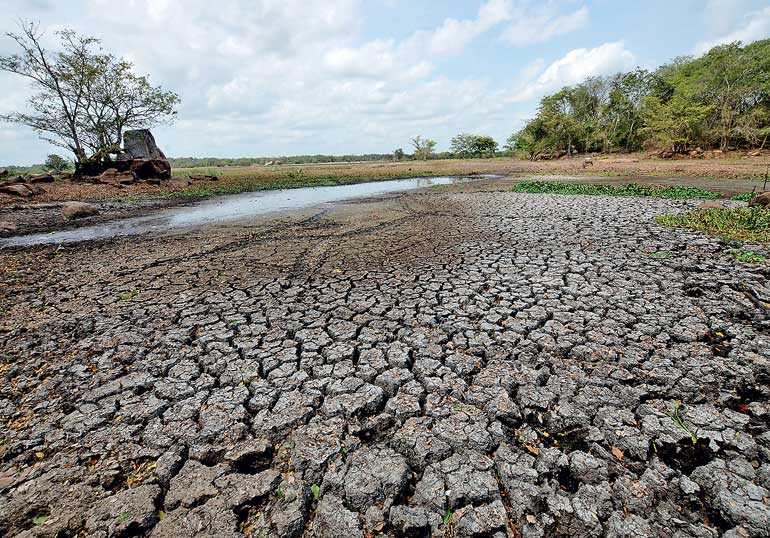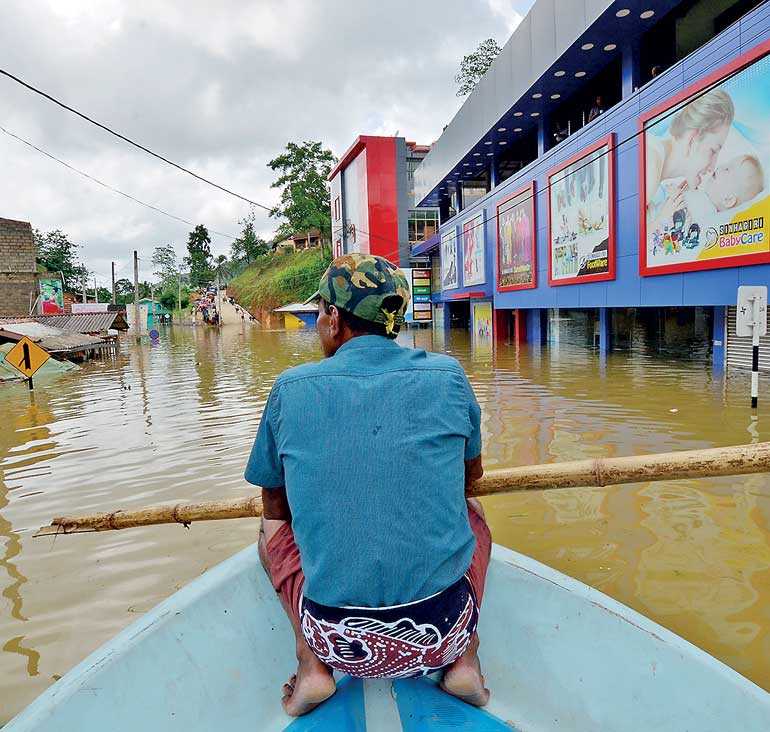Wednesday Nov 26, 2025
Wednesday Nov 26, 2025
Thursday, 6 December 2018 00:00 - - {{hitsCtrl.values.hits}}


UNFCCC has had 20+ conventions with Sri Lanka’s participation and we are (i) fourth most vulnerable country to Climate Change in the world as per German Watch’s Climate Risk Index Ratings, 2018 and (ii) most vulnerable country in South Asia according to World Bank’s Report ‘South Asia’s Hotspots’ of September2018.
Greenhouse Gas emissions has not decreased; but has continually increased during these 20+ years and UNFCCC and IPCC are now directing their efforts towards identifying ways and means of nullifying effect of doubling of CO2 concentration on mankind. This endeavour is called Geo-engineering (GE).
In October 2017 some world scientists met in Berlin to discuss future of GE and a subcommittee of US House of Representatives met in November2017 to discuss the same and discussions were predominantly in respect of Solar Radiation Management (SRM) which is a part of GE.
According to the publication ‘Geoengineering the Climate’ by the Royal Society, GE aims to “intervene in the climate system by deliberately modifying the Earth’s energy balance to reduce increases of temperature and eventually stabilise temperature at a lower level than would otherwise be attained”.
According to this publication, GE can be classified into two main groups (a) Carbon Dioxide Removal (CDR) and Solar Radiation Management (SRM).SRM does not plan to reduce GHGs, but only to buy time to let our descendants or heirs to find the solution for us, address it later and pay for it, if only, they also don’t want to keep it for their descendants.
Need of the hour for Sri Lanka
What we need for Sri Lanka to-day is a mitigation strategy which could be implemented fast, very, very fast. For 20+ years we had been waiting anxiously for UNFCCC and IPCC to provide us with a solution. But to-day, these organisations prompt interested parties – academicians, research organisation, energy administrators – to look at GE and identify a solution which will keep the atmosphere cool, even if CO2 concentration reaches 560ppm.
Out of such SRMs suggested and promoted by academicians of different universities, (a) Stratospheric aerosols, (b) Space reflectors, (c) Marine cloud brightening, (d) Oceanic mirrors, (e) Enhancing albedo of buildings and leaves are some of the better known and more discussed strategies. While stratospheric aerosols and space mirrors are expected to be implemented in stratosphere or above the troposphere, marine cloud brightening would be implemented in the clouds area in the atmosphere, and oceanic mirrors and surface albedo initiatives is meant for earth’s surface level.
When the Royal Society evaluated these different SRM Strategies on four criteria (i) Effectiveness, (ii) Affordability, (iii) Timeliness and (iv) Safety, Stratospheric Aerosols – i.e. spraying aerosol forming material like an oxide of sulphur into the stratosphere – scored 4 each (out of a total of 5) for first three criteria and it scored only a poor 2 in respect of safety.
Major objections to its safety were (a) need for adherence to international conventions on land and sea area usage, (b) ability to carry out a forced termination, (c) consequences of such a forced termination i.e. the unbearable enhanced global temperatures and (d) consequences of a natural volcanic eruption occurring while this been implemented.
What is available for Sri Lanka?
One needs to ask from all those who attend or attended IPCC or UNFCCC conventions what they have brought from those conventions which will help us to (i) face being fourth most vulnerable country in the world and (ii) reduce our vulnerability.
In today’s context, all what they could say will be, of course, wait till we finalise the most effective SRM technique.
So, shall we look at our own indigenous SRM technique, Highway Solarisation (HS) which is defined as a dedicated infrastructure for powering Battery Electric Vehicles (BEVs) or the grid, using solar energy collected by laying PV solar panels along and above the highways?
The definition of SRM has a few key characteristics as follows: (a) method should reduce net incoming shortwave solar radiation received(b) deflect sunlight and/or (c) increase albedo of the atmosphere, clouds or earth’s surface.
Highway Solarisation (HS): (a) reduces net incoming shortwave solar radiation received by the highway – the man-made surface on the earth – and (b) deflects sunlight without allowing it to impinge on the earth’s surface. While tarred surface would have absorbed 88-92% of incident solar radiation, the solar roof on the highway would convert 17% of incident solar radiation into electricity, reflect about 10% solar radiation and would absorb only 73% of solar radiation. So, there is a direct reduction of at least 17% in the absorbed solar radiation.
On the other hand, if this 17% energy converted to electricity is used for transportation via BEVs replacing Internal Combustion Engine powered automobiles, it would eliminate, 68% of waste energy emitted to the atmosphere by the ICE powered automobile. Even if it is used for providing electricity to grid, at least an additional 25% would be eliminated. So, the moment this waste energy component is also taken into consideration, the total benefit from HS will be anything from 42% to85% of incident solar radiation on the area covered by HS.
Other advantages of Highway Solarisation
From the view point of needs of SRM, HS has some significant advantages. SRM talks about increasing albedo of earthly surfaces; but does not talk about the ever-decreasing side of albedo. Earth’s albedo is eternally decreasing mainly due to the construction of roadways.
So, if we adopt HS as SRM solution for climate change, then we can ensure reduction of damage (i.e. loss of albedo) due to highway construction by ensuring that all new roadways are planned and built with HS. This would imply that when we build a roadway, we also bring energy for transportation as well. So, eliminating albedo reduction due to highway construction may be equally or even more important as enhancing albedo.
Some practical experiences
Three practical experiences come to our mind in respect of benefits from HS, all three in 2018.
1. It was in early January2018, Hume Highway in Australia had a 10 km stretch melted and the road was closed for a few weeks. It indicates the very low level of albedo of a highway. If the highway had been solarised, this would not have happened.
2. California experienced the worst patch of wild fires in the past few weeks followed by unprecedented rains thereafter. We believe that both these could be related to (a) the volcanic eruption in Hawaii and (b) very high levels of roadways in California. California has the second highest extent of roadways in USA, at 394,608 lane miles next to 675,580 lane miles in Texas. The air circulation model – Walkers Circulation – would show us how air currents from Hawaii at 155.58280W would move towards California at 119.41790W and there is a possibility that both these– fires as well as enhanced precipitation –have resulted from the same origin. Does it mean that what could be expected from stratospheric aerosols would vary with location depending on air circulation models?
3.World Bank in its report ‘Hotspots in South Asia’ declared that Sri Lanka and Bangladesh are the most vulnerable countries in South Asia and out of a few characteristics the Bank has considered in the report preparation, only characteristic which clearly differentiated these two countries were their high road densities – Sri Lanka at 13.5km/10km2 and Bangladesh at 5.8km/10km2.
These examples from three locations in the two hemispheres at different coordinates do indicate the damage highway construction could do to a country. It is in this context, that we propose our Highway Solarisation as a solution for climate change and our objective is not to frighten people away from highway construction but to show how HS could (a) reduce highways absorbing solar radiation and then emitting as long wave radiation, (b) generate electricity either for the grid or for BEVs, (c) generate energy without generating CO2 and (d) restrict loss of albedo of the earth’s surface due to Highway construction, etc.
Comparison of different SRM strategies
Now that we have looked at SRM strategies in general, and HS in particular, we can look at how HS matches and compares with these other SRM strategies. We will again be guided by the pronouncements of the Royal Society.
a. Effectiveness
Effectiveness is combination of (i) scientific and technological basis, (ii) technological feasibility (iii) magnitude of spatial scale and (iv) uniformity of the effect achievable.
Scientific and technological basis of PV solar panels usage as a method to provide renewable energy is well established.
HS is technologically feasible. But magnitude of spatial scale possible and uniformity of the effect achievable depend on the match between HS and energy uses to-day.
If one looks at HS purely as SRM technology, what it could achieve is only a meagre 0.14% land area coverage, not enhancing its albedo, but reducing absorption by 17% which will yield an overall weightage factor of only 0.2% compared with the desired requirement of enhancement of albedo to 1 on 10% of the land area.
But to compensate for this deficiency, 25 million km of roadways on the top 10 countries in the world could yield the entire energy requirement for electricity and transport sectors of the world – i.e. 25,551TWhrs of electricity and 6,048TWhrs of energy for transportation, the balance 24,192TWhrs of energy used by transportation in 2017had just been added to the atmosphere as waste energy heating up the globe. So, HS has the required magnitude and will also eliminate about 75,000 TWhrs of waste heat emitted by the electricity generation and transport sectors every year.
In respect of spatial scale again, HS provides superior match in the sense HS Provides higher levels of mitigation where it is needed the most. Wherever there is more energy been used for transport with wider roads and more energy been wasted, it will eliminate these to its full potential extent. In respect of uniformity, there may not be the perfect match as the solar irradiance that could be captured varies with the latitude of the locations, and, may be, even with the orientation of the roadways to N-S direction.
So, we could state with absolute certainty that HS has a much, much better effectiveness than all those SRM techniques considered up to now.
b. Timeliness
This parameter evaluates the State of Readiness for implementation and the speed with which the intended effect on climate change would occur.
HS is ready for implementation from day one, provided governments could provide the relevant approvals. Even the approval processes are straight forward as it will be put upon built up property. The effect on bothCO2 reduction as well as on albedo on the earth’s surface will be immediate.
The full implementation with about 25 million km of highways been covered with PV Solar panels to be completed in 38 years – the time it would take for CO2 concentration to increase from 410ppm to 560ppm at the rate of 4ppm per year – will depend on the availability of about 716GW of PV solar panels a year. Last year’s output was about 100GW.
So, we need to devote all our manufactured PV solar panels for HS if we are to achieve the resolution of climate change the way it happens with it.
If a PV solar panel that had been manufactured is to be used for climate change mitigation definitely and effectively, the same shall be used for HS.
c. Safety
Safety implies (i) predictability, verifiability of the intended effects, (ii) absence of adverse side effects and environmental impacts and (iii) low potential for things to go wrong on a large scale. Only side effects that one could think about is what happens if a vehicle collides with a column of the structure to which the panels are fixed. These columns could be provided with guard rails around them. On the other hand, most road vehicular accidents (about 75%) do occur due to wet surfaces from rain, snow or otherwise and with HS this tendency would be much less.
Excepting this, there are no other possible opportunities for things to go wrong.
d. Cost
What needs to be considered is the cost of both deployment and operation. This is where this strategy scores very high as it is completely self-sustaining.
The total cost of the project could be easily recovered in less than 10 years and the returns thereafter could be invested in more HS projects.
As such it could be seen that HS scores very high on all the four parameters generally used in evaluating SRM projects and it is unlikely that a better SRM would be identified for such early implementation.
Climate change mitigation shall enter implementation phase
During the first decade of this century, UNFCCC and IPCC were researching mostly about alternatives for energy to be used in transportation and electricity generation. Transportation research involved identification of a suitable alternative vehicle and a fuel to match the same. Most researches led to Battery Electric Vehicle as the preferred vehicle and once that decision was made the remaining research converged to one of finding alternative ways of generating electricity.
It is in this back-ground Ban Ki Moon, former UN Secretary General announced in September 2014 that (i) at least 30% new vehicle sales in cities in 2030 should be BEVs, (ii) they should be powered by renewable energy and (iii) deforestation should be reduced to 50% by 2030 and to 0% by 2050.This is what HS specifies.
Four years after Ban Ki Moon gave these guide lines and nine years after the Royal Society published its document on ‘Geoengineering the Climate,’ the climate system has only become worse as per IPCC’s latest announcements in Incheon, South Korea and USA’s fourth Climate Assessment Report put out on Black Friday.
Sri Lanka is the fourth most vulnerable country and USA is the 10th most vulnerable country out of a total of about 160 countries in the world as per Climate Risk Index published by German Watch. Different parts of the two countries experience different types of extreme weather at a given time.
Oil companies and reinsurers should take the lead and move mankind away from this oil-based economy towards a renewable energy based economy and there are adequate returns in it.
Oil companies will lose their monopoly of energising global mobility if they don’t invest in HS and as such should start investing in HS. On the other hand, re-insurers are the people who will ultimately bear the cost of destruction arising from disasters of whatever nature and therefore should invest in HS. But unfortunately, oil companies earn money from fossil fuels and if there is no risk and no vulnerability, people will not be interested in insurance. For reinsurers to be interested in climate change mitigation, the level of destruction should be so great that the premiums to be charged should make businesses unprofitable.
For one split second, we have taken our eyes away from the need for CO2 reductions. We have been duped by the Paris Accord and bringing in more natural gas to the energy mix and we have lost all our attention on GHG reductions. The world changed during that split second to a craving for SRMs – such grandiose plans, thoroughly unfounded– postponing the real issues of reducing GHGs and passing it on to those innocent infants of today and tomorrow, if they survive the barrage of droughts, cyclones, snow storms, floods, wild fires, whatever. No, let us not pass this on. Let us solve climate change forever.
Conclusion
Climate change can be solved by investing $ 1,074 billion per year and solarising about 550,000km of roadways in the world every year. The 10 top countries do have 25,000,000 km of roadways. We will need about 700GW of solar panels. To utilise about20% of the electricity generated in the process, the world will need about 60 million Battery Electric Vehicles to be manufactured every year.
Both these are possible in view of the estimates or targets mentioned in UNEP’s document ‘Green Economy’ published in June2011.This report, which contained contributions from not only the climate scientist fraternity, but also from the top rungs of the financial management establishments like Bloomberg, Deloitte, PWC, E &Y, etc. predicted that the world will have to spend about $ 1.4 trillion/year to get over the travails of climate change.
It further specified what world will have to spend for energy projects and for transport projects and also predicted that if we start investing about 0.34% of a country’s GDP on alternative vehicles, we could bring about 80% penetration within 40 years and have 10% additional employment. These estimates match well with HS and the objectives we could set for ourselves.
So, our solution for climate change matches very well with the UNEP document developed in 2011 with contributions from the best financial brains available then.
Our resolve to-day on this would decide between whether we and our grandchildren survive climate change or perish due to it.
(The writer is Managing Director, Somaratna Consultants Ltd.)